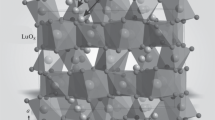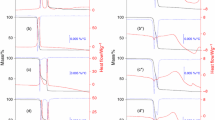Abstract
The purpose of this research was to study the best conditions for the synthesis of the double oxides Li5AlO4 and Li3AlO3 in the solid state starting from the simple oxides, and to determine their heats of formation.
Li5AlO4 was obtained from Li2O2 or Li2O and γ-Al2O3 in a Li/Al molar ratio of 5∶1, and was characterized by X-ray methods. Lithium orthoaluminate, Li3AlO3, was obtained from Li2O2 and γ-Al2O3 in a molar ratio 3∶1. The postulated formula, Li3AlO3, was confirmed by chemical analysis.
The temperature ranges in which the compounds are stable were established by the DTA method, and were found to be very limited for Li3AlO3 (400–430°) but greater for Li5AlO4 (440 — more than 600°).
The heats of formation of Li5AlO4 and Li3A103, also determined by means of the DTA method, were found to be −552.3 ± 0.8 kcal/mole and −416.8 ± 2 kcal/mole, respectively.
Résumé
On a recherché les meilleures conditions pour réaliser la synthèse à l'état solide des oxydes doubles Li5AlO3 et Li3AlO3 en partant des oxydes individuels et pour déterminer leur chaleur de formation. Li5AlO4 a été obtenu en partant de Li2O2 (ou Li2O) et de γ-Al2O3 dans le rapport molaire Li/Al=5/1; il a été caractérisé par étude aux rayons X. L'orthoaluminate de lithium, Li3AlO3, a été obtenu en partant de Li2O2 et de γ-Al2O3 mélangés dans le rapport 3/1. L'analyse chimique a confirmé la formule présumée Li3AlO3. L'ATD a permis de déterminer le domaine de stabilité thermique de ces composés: très restreint pour Li3AlO3 (400–430°), plus grand pour Li5AlO4 (440-plus de 600°), ainsi que leurs chaleurs de formation: −416.8±2 kcal/mole et −552.3±0.8 kcal/mole, respectivement.
Zusammenfassung
Es wurden die Bildungsverhältnisse der doppelten Oxide Li5AlO4 und Li3AlO3 in fester Phase ausgehend von den einfachen Oxyden geprüft und ihre Bildungswärmen bestimmt. Li5AlO4 wurde aus Li2O2 oder Li2O und γ-Al2O3 beim Molverhältnis von Li/Al 5 ∶ 1 erhalten und röntgenographisch identifiziert. Das Orthoaluminat Li3AlO3 erhielt man beim Molverhältnis 3 ∶ 1 von Li2O2 und γ-Al2O3. Die Zusammensetzung von Li3AlO3 wurde durch chemische Analyse nachgewiesen. Die DTA-Prüfung zeigte, daß Li3AlO3 nur im sehr kleinen Temperaturgebiet (400–430°), Li5AlO4 hingegen im weiteren Bereich zwischen 440–600° stabil ist. Die Bildungswärmen betrugen für Li5AlO4 −552.3±0.8, für Li3AlO3 −416.8±2 kcal/Mol.
Резюме
Цель исследования — п оиск наилучших услов ий синтеза двойных окис ей Li5AlO4 и Li3AlO3 в твердой фазе н а основе простых окис ей и определение теплот и х образования. Li5AlO4 получен из Li2O2 или Li2O и γ-Аl2О3 при молярном соотношении Li/Al 5∶1, и его структура под тверждена рентгендифракционн ым методом. Ортоалюми нат лития, Li3AlO3, получен из Li2O2 и γ-Аl2О3 при молярном соотношении 3∶1. Предполагаемая форм ула подтверждена хим ическим анализом. Методом ДТА установлено, что область температ ур, в которой эти соеди нения стабильны, довольно о граничена для Li3AlO3 (400—430 °?) и более широ кая для Li5AlO4 (440- ≤ 600 °?). Теплоты образования Li5AlO4 и Li3AlO3 та кже определены с помо щью метода ДТА и составляют 552.3 ± 0.8 и 416.8 ± 2 Кка л/мол, соответственно.
Similar content being viewed by others
References
L. Debray andA. Hardy, Compt. Rend. Acad. Sci. Paris, 251 (1960) 725.
P. Hagenmuller andL. Debray, ibid., 250 (1960) 134.
E. Kordes, Z. Krist., 91 (1935) 193.
H. A. Lehmann andH. Hesselbarth, Z. anorg. allg. Chem., 313 (1961) 117.
E. Zintl andW. Morawietz, ibid., 236 (1938) 372.
F. A. Hummel, B. S. R. Sastry andD. Wotring, J. Am. Ceram. Soc., 41 (1958) 88.
H. A. Lehmann andH. Hesselbarth, Z. anorg. allg. Chem., 315 (1962) 14.
K. Torkar, H. P. Fritzer andH. Krischner, Science of Ceramics, 2 (1962) 19.
C. Kröger andE. Fingas, Z. anorg. allg. Chem., 224 (1935) 289.
T. F.Fedorov and F. I.Shamrai, Prim. Vak. v. Met., Akad. Nauk SSSR, Inst. Met. im A. A. Baikova, 137 (1960).
C.Duval, “Inorganic Thermogravimetric Analysis”. Elsevier Publ., 1963, pp. 166–167.
ASTM X-ray Powder Data File, Baltimore, Md., 1957.
C. E.Wicks and F. E.Block, Thermodynamic Properties of 65 Elements. Bureau of Mines, Bull. no. 605.
Handbook of Chemistry and Physics, 49th Edition, 1968. The Chem. Rubber Co., Cleveland, Ohio, p. D 38 and following.
B. S. R. Sastry andF. A. Hummel, J. Am. Ceram. Soc., 42 (1959) 216.
Author information
Authors and Affiliations
Rights and permissions
About this article
Cite this article
La Ginestra, A., Lo Jacono, M. & Porta, P. The preparation, characterization, and thermal behaviour of some lithium aluminum oxides: Li3AlO3 and Li5AlO4 . Journal of Thermal Analysis 4, 5–17 (1972). https://doi.org/10.1007/BF02100945
Received:
Revised:
Published:
Issue Date:
DOI: https://doi.org/10.1007/BF02100945




